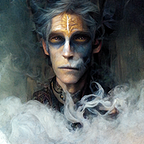The MidJourney Lexicon
Whether you think it is simply a new artistic tool or a new form of artistic expression, artificially generated art is here to stay. One of the things every new art process gets to create are words about the process. Think of the concept of burning and dodging which didn’t exist before photography. Or layers, made popular by photoshop. AI-generated art is no different.
There are, of course, already some community accepted standards such as:
Grid which is the 2x2 panel from your prompt
V-Roll which is what you do when you select a variant, making a new grid
Reroll is when you use the same prompt to get a new grid
But I think we can do better than that. For example, I’ve noticed that most people fall into one of two camps when using MidJourney.
The first are the Prompt Jockeys. These are the wizards of the MJ universe. They are the users that excel at crafting the most complex arcane prompt possible in order to tease the AI to give them exactly the imagine the user wants. They rely heavily on descriptors and parameters, blended with styles and chaos, factoring in word order and weight assignment. These are the people that not only know the value differential between a comma, a space, and a double colon, but they understand when and how to use them to get what they want.
An example I grabbed from the “wilds” in the MJ discord to illustrate it:
The geometric illuminati, the father of power, tarot black and gold, black paper, fine point ink, stipple shading, volumetric lighting, glitchcore:: infrared black and white photography :: ominous seraphim-like angel, glowing gold void eyes, creation runes, illustrated by Kentaro Miura, monochromatic manga cover, symmetrical, bold black and white geometric details :: spacecore fantasypunk synthwave, symmetrical red crimson and black ink, full art geometric skeletal goddess of Death :: The geometric lich queen unreal engine, gauche monochromatic illustration by Kentaro Miura and Alphonse Mucha and Jungi Ito and Chris Foss :: 8k, unreal engine epic, ocult character symbolism — ar 9:21 — chaos 20 — stylize 3000 — q 2 — no long neck, two face, extra face
Prompt Jockeys would relish the opportunity to merge their mind with that of the AI. They generally see MJ as an artistic tool to be used to help them reach the heights of their creative potential.
This is directly counter to the other extreme, the V-Rollers.
V-Rollers approach MJ from the heart. While they won’t (outright) admit that they believe MJ is sentient, they kinda sorta believe/wish/hope that it is and will communicate back with them as if MJ was the Holmes IV from The Moon is a Harsh Mistress. If a Prompt Jockey is the Spock on the U.S.S. MidJourney, V-Rollers are the Deanna Troi.
V-Rollers use the prompt as a conversational opening with the AI and then explore the results which arrive. They are the sorcerers of MJ. They might be single word minimalists (from the wild: “Rick” or “Anger”), ask MJ philosophical questions (“what does it sound like when a tree falls in an empty forest?”), or even chat with it (“What do you look like?”) Regardless of the initial prompt, what they are after is the variation possibilities.
Once the initial grid arrives V-Rollers will select one or more of the four and then roll for variations. They’ll keep it up until an imagine arrives that they can connect with. Not always one that answers the question of the prompt, of course. But one that they can emotionally relate with. Then they are satisfied that they understand just a little bit more about MJ and it understands just a little bit more about humanity.
The final term I’ll suggest deals with the most controversial of subjects: what to call the final output of an AI-art generating application. I have steadfastly used the term Imagines. This was coined in part because the most popular AI-art-generator, MidJourney, uses the command prompt /imagine to initiate the process. I submit it is preferable to refer to the images as imagines rather than drawing or painting or digital photographs because while the output of the AI can mimic these quite amazingly (and sometimes, quite atrociously), those other terms bring in a lot of other connotations–including, but not limited to, something that the human artist actually made. In the case of the imagines, it is the AI which is making them. The human artist simply imagined it.
If you have any suggestions or ideas for other useful terminology that you’d like to add to the list, by all means leave a comment or note.
